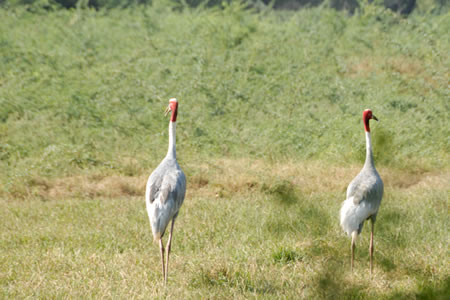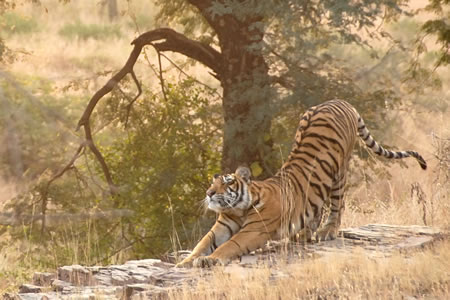English | Dutch |
|
| Life is good! | |
:Alwar (India) to Bundi (India), Oct-09-07 / Oct-20-07 |
|
Last days we have soaked up the splendour of the animal world. From Alwar we took the bus to Bharatpur which houses the Keoladeo Ghana National Park (Keoladeo). This park is an Unesco Wold Heritage Site because it is one of the world’s most important birds breeding and feeding grounds. At least 371 kinds of birds live inside the 29 square kilometres of the park. This makes it possible to spot many different birds on a single day. We hope to find out if that is even true for inexperienced birders watchers like us. After arrival in Bharatpur, we hired a room in a small guesthouse which is owned by two brothers. One of these men (Tarun) is also a guide/naturalist in the park. We ask him to guide us the following day for five hours. In these hours he can teach us the ropes in the park. Afterwards we want to explore the park ourselves.
The following day starts early. De alarm clock tinkles at 5.00 and after having breakfast we arrive at 6.30 at the entrance of the park. At the entrance, we hire binoculars and bicycles. Motorised means of transport are forbidden within the boundaries of the park, so bicycles and cycle-rickshaws are the only option if you don’t want to walk all day. The cycle-rickshaws are only allowed to drive on the main paths and are mostly used by people from tour groups, who spend only a few hours in the park. Cycling is the best option if you want to explore the whole park and if you want to decide for yourself when you want to stop to look for a bird. Short after we started, we cycle into a sandy path. We park the bicycles and while we walk along the path our eyes try to find different birds in the bushes. Soon we realise that it is possible to see many birds in a day. Within a kilometre we spot at least 25 different species of birds. Of course, certain birds are more spectacular than the other but the Yellow-crowned Woodpecker, the Asian-Paradise Flycatcher and the Golden Oriole certainly awake the bird-watcher in us. For us it was very important to have a good guide accompanying us. In our search to see the Dusky Eagle Owl we went to a part of the park that is less visited by tourists. We would probably have overlooked this magnificent large owl (more than half a metre tall) if Tarun hadn’t pointed him out. |
|
 |
|
Finally they are there, the Sarus cranes |
|
| Time flies and soon there is not a single minute left of the five hours that we booked Tarun. During these hours we have seen how valuable a good guide is. Therefore, we ask Tarun to accompany us for the rest of the day. Fortunately he has no other plans for the remainder of the day, so we can also make use of his knowledge during the afternoon. At 18.00 o’clock, a beautiful day comes to an end. During this day we saw more than 70 kinds of birds. This variety of birds is impressive but there is one animal that made the biggest impression on us: a Rock-Python of nearly three metres who lay quietly on the path. This constrictor waited patiently for 15 minutes before he went back to the bushes, so we could take a good look at him.
After a deserved day of rest, we visit Keoladeo again. This time we set off without a guide, but again armed with binoculars and bird field guide. There is one kind of bird that we really would like to see and that we didn’t saw on the first day. The Sarus Crane is 1.65 metre tall and the world’s largest flying bird. It is also a very steadfast kind of bird because they stay with the same partner all their lives. Tarun even told us that if one Sarus Crane dies his partner will die within a few days. Enough reason for us to go and look for this illustrious bird. To tell a long story in a few words: we saw the Sarus Crane! We saw two Sarus cranes standing next to the waterline and we saw them a few hours later while they flew over. Also the remainder of the day was great. It is no problem at all to enjoy yourself for two full days in Keoladeo. On this second day we spotted six “new” kind of birds but we also savoured of the moments that antelopes come very close by when you are sitting on a bench. As the python already proved a few days ago, birds are not the only inhabitants of this park. Antelopes, Sambars, Jackals and Spotted Deer are easily observed from a close distance. | |
 |
|
Having a strech in the early morning sun |
|
After our visit to Keoladeo, we are anxious to visit another national park. Therefore, we travel to Sawai Madhopur for Ranthambhore National Park. This park is one of the places in India where you can see a Bengal Tiger in the wild. The chances of seeing such a big cat are rather high. So, it is understandable that this park is a popular tourist attraction. Every morning and every afternoon, a maximum of 12 jeeps and 22 canters go into the park for a 3 hour safari. Canters are a kind of open busses without a roof that can transport 20 people. Because jeeps have to be booked several months in advance, the only option that we have is to take a canter. Therefore, we book two seats on the morning safari of the next day. Again, this means that we have to get up early. The canter picks everybody up between 6.00 and 6.30 am. When the canter arrives at our hotel there are only a few seats left. People are laughing and talking, which contributes to the atmosphere of going to an animal amusement park. Our driver gets out of the canter at the entrance of Ranthambhore. He has to perform an important task that will largely affect the chances of seeing a tiger. All drivers have to draw lots to determine on which track they are allowed to drive. It is the park’s policy to distribute all jeeps and canters proportional over five tracks. They say that the chances to see a tiger is equal on every track, but after some investigation we came to know that tracks two and three are better. Today, we have bad luck. We have to ride on track one, on which there is not seen a tiger in the last five days. Unfortunately, today there is also no tiger to be seen here. The people behind us in the canter are chatting like they are in the pub and the man next to us is taking a nap. The animal amusement park atmosphere is making it difficult to enjoy the landscape of the park. You don’t feel like you are on a safari, also because drivers are not allowed to drive on different tracks to search for a tiger. After three hours we go back to the hotel. We are a little disappointed but determined to see a tiger on the next morning safari. We are positively surprised when the canter picks us up next morning. This time we are the first to be picked up; therefore we can select good seats in the canter. When our canter is filled up, we leave for the park. This time, the lottery of the tracks ends in our favour. Today we will drive on track two. As soon as we enter the park we glance at a beautiful tigress who is sitting in the early morning sunlight. Animal amusement park atmosphere or not, we have enjoyed the sight on this great animal a lot. After a while she came nearer. She was only five metres away giving us the possibility to observe her very well. Our meeting with the tigress lasted thirty minutes and then she disappeared into the bushes. Excited about our encounter with the tigress, we drive along the remainder of the route hoping to see another tiger. That was not meant to be, but when we return to our hotel we still feel very content. That night we toasted with a cold beer on our first sighting of a wild tiger. The next morning we exchanged the nature parks for some of the beautiful cultural inheritance that this part of Rajasthan has to offer. We travelled with the unreserved, second class train (see also the article: cattle class) to Kota to travel onwards to Bundi. At this moment we are in Bundi and we are enjoying the visits to beautiful palaces and great forts. At night, when we are looking in our guidebooks, we almost can’t wait to visit all the beautiful places that we haven’t seen yet. We have seen already so many great things but there is so much more to explore. Therefore, we often say to one another: life is good! See also the photo impression of Keoladeo Ghana National Park
|
|
| <Previous weblog> | |